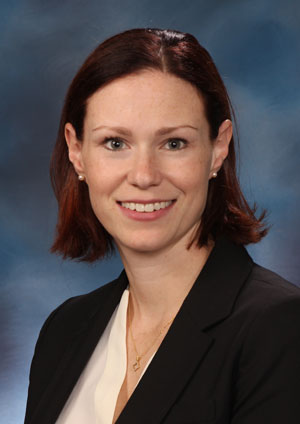Team Hydro is incredibly proud to announce an exciting research update!
Dr. Jennifer Strahle, recipient of a 2016 Innovator Award from Team Hydro, has been awarded a $2.4 million dollar grant from the NIH to work on Hydrocephalus. This award is a direct result of the data she generated using funds from Team Hydro and the Hydrocephalus Association, and is yet another example of our research investment thesis in action.
To learn more about Dr. Strahle and her research, see our interview with her below.
______________________________________________
Dr. Jennifer Strahle is a practicing neurosurgeon and the current director of the Pediatric Neuro Spine Program at St. Louis Children’s Hospital. She is also an assistant professor at the Washington University School of Medicine, where she runs her own research laboratory.
In 2016, Team Hydro was proud to sponsor Dr. Strahle by funding an Innovator Award to investigate the role of iron in mediating ventricular injury in posthemorrhagic hydrocephalus. This seed grant has now born fruit, as the data it produced has resulted in a $2.4 million dollar follow-on grant from the National Institutes of Health.
We caught up with Dr. Strahle to hear about what brought her into Hydrocephalus research and to learn more about the exciting work going on in her lab.
TEAM HYDRO: Thanks so much for taking the time to chat with us! Amongst our grantees, you are one of a few who has opted for a dual-career as both a physician and a researcher. What made you want to become a surgeon-scientist?
Dr. Strahle: I have always had a fascination with the brain, dating back to my days as a neuroscience major in college. After college, I worked for two years in a research lab studying Alzheimer’s disease. Although I greatly enjoyed this work and felt like I had the potential to make a difference in people’s lives, it seemed that becoming a surgeon-scientist would allow me to be maximally impactful – being able to directly improve the lives of children with brain diseases while discovering new ways to treat or prevent these same diseases in my lab.
TEAM HYDRO: What motivates you to work on hydrocephalus specifically?
Dr. Strahle: Over the course of my lifetime, we have seen tremendous progress in cancer care, treatment of heart attacks, and organ transplantation. Yet hydrocephalus care has remained largely unchanged for the past fifty years. As a pediatric neurosurgeon, I see first-hand the devastating toll that hydrocephalus has on children and their families, and the enormous potential that improving care for these children can have for generations.
TEAM HYDRO: You certainly don’t have to convince us on that point! Thank you for working on this much under-appreciated condition. Could you tell us a bit about your current work in St. Louis?
Dr. Strahle: I split my time roughly equally between my pediatric neurosurgical practice at St. Louis Children’s Hospital and my lab at Washington University School of Medicine. In the lab, we are studying the role of cilia, tiny hair-like structures that line the ventricles, in the development of hydrocephalus after neonatal intraventricular hemorrhage. We are first seeking to more clearly understand the ways that the initial bleed leads to hydrocephalus, after which we hope to develop ways to minimize or prevent the damage to the underlying brain. My clinical practice focuses on hydrocephalus, brain tumors, and diseases of the spine. Running between the operating room, the clinic, and my lab can make for some hectic days, but the synergies between the different components of my job are energizing and make for a wonderful career.
TEAM HYDRO: What challenges do you see as a surgeon treating patients with hydrocephalus?
Dr. Strahle: As with any illness affecting very young infants, I view the most challenging part as helping patients and families cope with all the unknowns – infancy is a challenging time under the best of circumstances, and hydrocephalus specifically can be unpredictably variable in a way that causes enormous stress on families. From a more tangible perspective, having a shunt placed with the possibility of multiple revisions is a very real challenge for many children. My goal as a researcher is to eliminate the need for shunts for as many children with hydrocephalus as possible.
TEAM HYDRO: Eliminating the need for shunts is truly the ultimate dream in this field. As we work towards that goal, what are some of the big opportunities you see for future hydrocephalus research?
Dr. Strahle: As I alluded to above, the major opportunity in hydrocephalus research is to develop preventive treatments to eliminate or minimize the development of hydrocephalus. Our hydrocephalus researchers at Washington University are studying multiple mechanisms – iron metabolism, cilia injury, ependymal injury, and neural cell migration to name a few – that all likely play some role in the development of hydrocephalus and its coincident injuries. I don’t yet know which one of these pathways could ultimately lead to a cure for some or all children who would otherwise develop hydrocephalus, but I truly believe we will get there during my career.
TEAM HYDRO: Wonderful. One last question for our readers and donors: could you comment briefly on the role that grants like your Innovator Award play exciting new labs like yours?
Dr. Strahle: Support from the Innovator Award has been instrumental in allowing my lab to obtain preliminary data to apply for extramural NIH funding. With this initial support, we were able to identify several novel therapeutic targets within the iron handling pathway. This will be the focus of our upcoming areas of investigation and our NIH grant.
TEAM HYDRO: We sure are proud and grateful to be supporting researchers like you, Dr. Strahle! Thank you so much for all your work, and we look forward to continuing to follow your exciting career moving forward.
Learn more about the grants we sponsor at teamhydro.org/our-research/, and donate today at donate.teamhydro.org.
